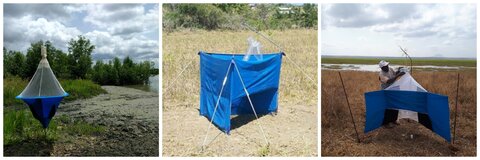Why are most traps coloured blue and black?

Tsetse have colour vision, as elegantly demonstrated by the aptly-named Dr Green! He compared the catches from variously coloured targets, and found that the numbers of tsetse attracted to a target increased in the order yellow < green < red < blue. Black was roughly as attractive as blue but, importantly, tsetse land on black in preference to any other colour. So we use blue to attract tsetse to an object and black to get them to land on it, which is why many targets are blue and black and why we only need to apply the insecticide to the black portion.
What do you think would happen with a black trap?
A black trap would be a very poor trap: it attracts many tsetse but they land on the outside of it and thus few enter into the trap to be caught. So it is attractive but not efficient. In general, the outside of tsetse traps are blue which attracts tsetse to the vicinity and the inside often has black panels to lure tsetse in.
References
Green, C.H. (1986) Effects of colours and synthetic odours on the attraction of Glossina pallidipes and G. morsitans morsitans to traps and screens. Physiological Entomology, 11, 411-421.
Green, C.H. (1988) The effect of colour in trap- and screen-orientated responses in Glossina palpalis palpalis (Robineau-Desvoidy)(Diptera: Glossinidae). Bulletin of Entomological Research, 78, 591-604.
Green, C.H. (1989) The use of two-coloured screens for catching Glossina palpalis palpalis (Robineau-Desvoidy)(Diptera: Glossinidae). Bulletin of Entomological Research, 79, 81-93.
Green, C.H. (1990) The effect of colour on the numbers, age and nutritional status of Glossina tachinoides (Diptera: Glossinidae) attracted to targets. Physiological Entomology, 15, 317-329.
Green, C.H. (1994) Baits methods for tsetse fly control. Advances in Parasitology, 34, 229-291.
Green, C.H. & Cosens, D. (1983) Spectral responses of the tsetse fly Glossina morsitans morsitans. Journal of Insect Physiology, 29, 795-800.
Green, C.H. & Flint, S. (1986) An analysis of colour effects in the performance of the F2 trap against Glossina pallidipes Austen and G. morsitans morsitans Westwood (Diptera: Glossinidae). Bulletin of Entomological Research, 76, 409-418.